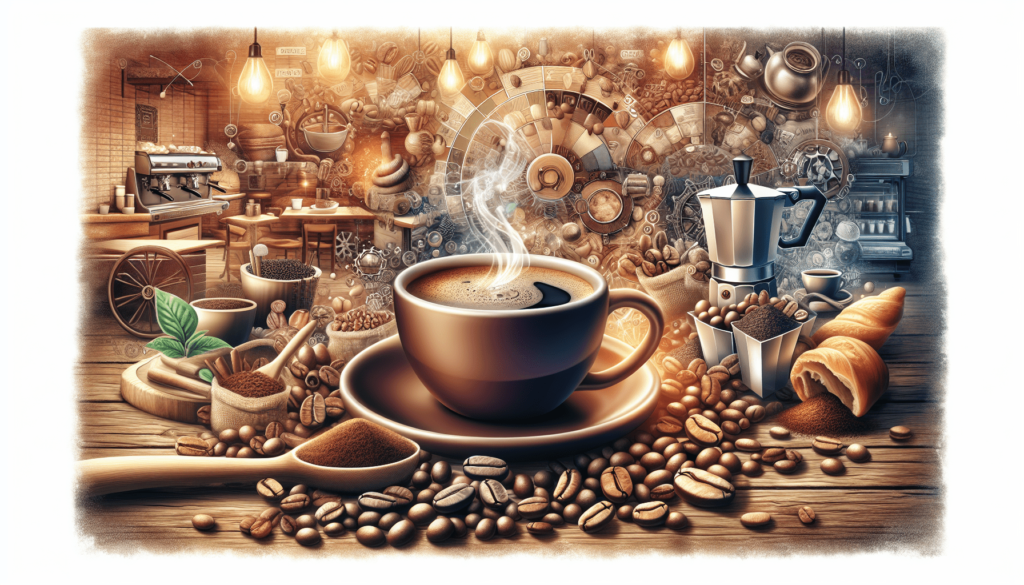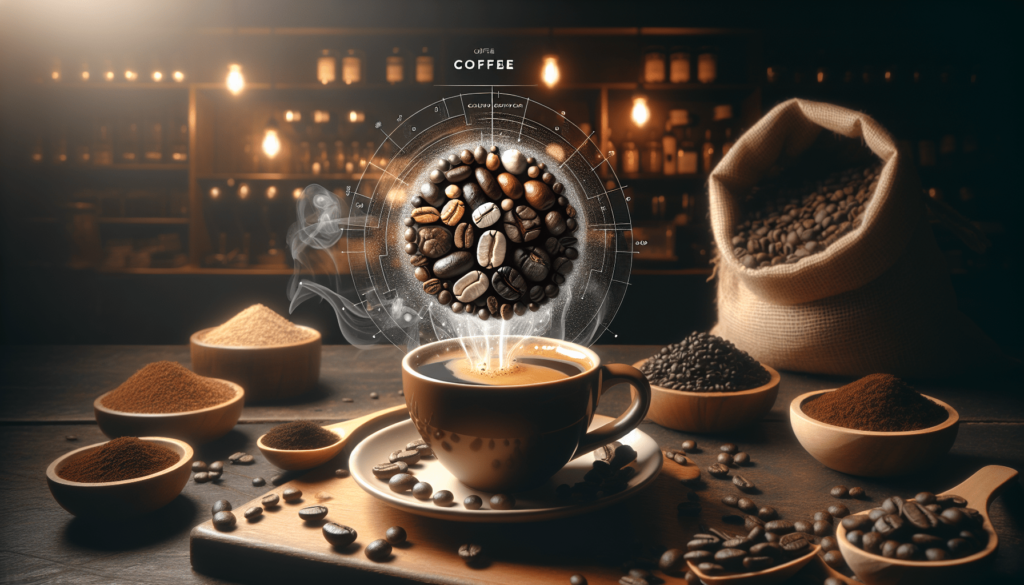Have you ever pondered what the best type of coffee is? With so many varieties, roasts, and brewing methods, it can be overwhelming to choose just one. Whether you’re a coffee novice or a seasoned aficionado, understanding the different aspects of coffee can significantly enhance your daily cup. In this comprehensive guide, we will explore various types of coffee, focusing on their unique characteristics, origins, and brewing methods. By the end of this article, you’ll have a clearer insight into what kind of coffee may be the perfect fit for you.

Understanding Coffee Beans
Before diving into the different types, you must understand the primary components that make up your coffee: the beans. Coffee beans come in various types, each offering unique flavor profiles and characteristics.
Arabica Beans
Arabica beans are the most popular type of coffee beans, making up about 60-70% of the world’s coffee production. They are known for their wide range of taste profiles, often described as smooth and complex, with notes of fruit, sugar, and berries.
| Key Characteristics | Arabica Beans |
|---|---|
| Flavor Profile | Smooth, complex, fruity notes |
| Caffeine Content | Moderate |
| Acidity | High |
| Common Growing Regions | Latin America, Africa, Asia |
Robusta Beans
Robusta beans are less popular but have a significant presence in the coffee world, known for their strong, bold flavors and higher caffeine content. They are often used in espresso blends and instant coffee.
| Key Characteristics | Robusta Beans |
|---|---|
| Flavor Profile | Strong, robust, bitter notes |
| Caffeine Content | High |
| Acidity | Low |
| Common Growing Regions | Africa, Indonesia, India |
Exploring Coffee Varieties
Once you understand the basic types of coffee beans, it’s essential to learn about various coffee varieties, which are combinations of beans and brewing methods.
Espresso
Espresso is a concentrated coffee usually served in small, strong shots. Unlike regular coffee, which is brewed through a filter, espresso is made by forcing hot water through tightly packed coffee grounds.
| Aspect | Details |
|---|---|
| Origin | Italy |
| Brew Time | 20-30 seconds |
| Common Uses | Base for other drinks like lattes and cappuccinos |
Americano
An Americano is a coffee drink made by adding hot water to a shot of espresso, giving it a similar strength but different flavor than traditionally brewed coffee. This drink originated during World War II when American soldiers stationed in Italy found espresso too strong and diluted it with hot water.
| Aspect | Details |
|---|---|
| Origin | Italy |
| Flavor Profile | Less intense than espresso |
| Brew Time | Similar to espresso, with additional time for adding water |
Latte
A latte consists of a shot of espresso, steamed milk, and a small amount of milk foam on top. This milk-heavy drink is perfect for those who prefer a softer coffee flavor.
| Aspect | Details |
|---|---|
| Origin | Italy |
| Flavor Profile | Creamy, smooth |
| Common Additions | Flavored syrups like vanilla, caramel |
Cappuccino
Cappuccino is similar to a latte but has a thicker layer of milk foam and is usually served in smaller portions. It’s a well-balanced drink suitable for various times of the day.
| Aspect | Details |
|---|---|
| Origin | Italy |
| Flavor Profile | Balanced, creamy |
| Ratio | Equal parts espresso, steamed milk, and foam |
Appreciating Coffee by Region
The flavor of your coffee can also be influenced significantly by its region of origin. Different growing conditions, altitudes, and soils contribute to the distinctive tastes and aromas of regional coffees.
Latin America
Latin American coffees are often bright with a clean, crisp flavor and a hint of nut or chocolate.
| Region | Characteristics |
|---|---|
| Colombia | Medium-bodied, balanced acidity, nutty flavors |
| Brazil | Heavy-bodied, low acidity, chocolatey notes |
| Guatemala | Spicy, chocolatey flavors, high acidity |
Africa
African coffee is known for its complex flavors, often fruity or floral, with high acidity.
| Region | Characteristics |
|---|---|
| Ethiopia | Varied profiles, floral, fruity, high acidity |
| Kenya | Bright, wine-like acidity, fruity flavors |
| Rwanda | Balanced, citrusy, floral notes |
Asia
Asian coffees generally offer a rich, full-bodied experience with earthy, spicy flavors.
| Region | Characteristics |
|---|---|
| Indonesia | Earthy, smoky, full-bodied |
| Vietnam | Strong, robust, often used for iced coffee |
| India | Spicy, bold flavors with a unique kick |
The Art of Roasting Coffee
Roasting is another crucial factor that influences the flavor and aroma of your coffee. Different roasting levels can bring out unique characteristics in the beans.
Light Roast
Light roast coffee beans are roasted for a shorter time, resulting in a light-bodied coffee with high acidity. They often have bright, fruity flavors but can be more acidic.
| Roast Level | Characteristics |
|---|---|
| Light Roast | Fruity, acidic, more caffeine |
| Common Uses | Pour-over, French press |
Medium Roast
Medium roast beans offer a balanced flavor profile and moderate caffeine content. They have a fuller body than light roast and carry a mix of fruity and sweet flavors.
| Roast Level | Characteristics |
|---|---|
| Medium Roast | Balanced, sweet, moderate acidity |
| Common Uses | Drip brewing, espresso |
Dark Roast
Dark roasts are roasted for the longest time, resulting in a bold, rich flavor with a fuller body. These beans often have a lower acidity and a more pronounced bitterness.
| Roast Level | Characteristics |
|---|---|
| Dark Roast | Rich, bold, low acidity |
| Common Uses | Espresso, drip brewing |

Brewing Methods: From Home to Café
Different brewing methods can drastically alter the taste of your coffee, even when using the same beans. Here’s a look at some popular brewing methods.
Drip Coffee Maker
Drip coffee makers are one of the most common brewing methods for home use. This method is convenient and allows you to brew large quantities at a time.
| Aspect | Details |
|---|---|
| Brew Time | 5-10 minutes |
| Flavor Profile | Balanced, smooth |
| Ease of Use | High |
French Press
The French Press is a classic brewing method that allows for full immersion of the coffee grounds, resulting in a robust and rich flavor.
| Aspect | Details |
|---|---|
| Brew Time | 4-5 minutes |
| Flavor Profile | Rich, full-bodied |
| Ease of Use | Moderate |
Espresso Machine
Espresso machines use pressure to force hot water through finely-ground coffee, creating a concentrated and bold shot. They are essential for making espresso-based drinks like lattes and cappuccinos.
| Aspect | Details |
|---|---|
| Brew Time | 20-30 seconds |
| Flavor Profile | Concentrated, bold |
| Ease of Use | Low |
Pour-Over
The pour-over method allows for precise control over the brewing process, often resulting in a cleaner and more nuanced flavor.
| Aspect | Details |
|---|---|
| Brew Time | 3-4 minutes |
| Flavor Profile | Clean, nuanced |
| Ease of Use | Moderate |
Cold Brew
Cold brew coffee is made by steeping coarsely ground coffee in cold water for an extended period, usually 12-24 hours. This method produces a smooth and mellow coffee, which is often less acidic.
| Aspect | Details |
|---|---|
| Brew Time | 12-24 hours |
| Flavor Profile | Smooth, low acidity |
| Ease of Use | Low |
Specialty Coffee Drinks
Beyond the basic coffee drinks, there are numerous specialty options to explore. These drinks often combine various ingredients to create unique and flavorful experiences.
Mocha
Mocha is a delightful blend of coffee and chocolate, usually topped with whipped cream. It’s a popular choice for those who enjoy a sweet treat.
| Aspect | Details |
|---|---|
| Main Ingredients | Espresso, steamed milk, chocolate syrup |
| Flavor Profile | Sweet, chocolatey |
| Common Variations | White mocha, dark mocha |
Macchiato
A macchiato is an espresso shot “stained” with a small amount of milk, offering a strong coffee flavor with a hint of creaminess.
| Aspect | Details |
|---|---|
| Main Ingredients | Espresso, a dash of milk |
| Flavor Profile | Strong, creamy |
| Serving Size | Small |
Flat White
Originating from Australia and New Zealand, a flat white consists of a shot of espresso topped with microfoam, creating a velvety texture.
| Aspect | Details |
|---|---|
| Main Ingredients | Espresso, microfoam |
| Flavor Profile | Smooth, creamy |
| Serving Size | Medium |
Decoding Coffee Strength
Understanding coffee strength can help you choose a coffee that aligns with your preferences. Coffee strength doesn’t just depend on the roast level but also on the brewing method and coffee-to-water ratio.
Strong Coffee
Strong coffee usually has a higher coffee-to-water ratio and often uses dark roast beans. It is bold and intense.
| Characteristics | Details |
|---|---|
| Caffeine Content | Higher |
| Flavor Profile | Bold, intense |
| Common Examples | Espresso, French press |
Mild Coffee
Mild coffee tends to have a lower coffee-to-water ratio and can use lighter roasts. It is more balanced and less intense.
| Characteristics | Details |
|---|---|
| Caffeine Content | Lower to moderate |
| Flavor Profile | Smooth, balanced |
| Common Examples | Drip coffee, pour-over |
Health Benefits of Coffee
Drinking coffee extends beyond the enjoyment of different flavors and textures. There are several health benefits associated with moderate coffee consumption.
Antioxidants
Coffee is rich in antioxidants, which help combat free radicals in the body and reduce inflammation.
Mental Alertness
The caffeine in coffee can enhance mental alertness and concentration, making it a popular choice for those needing a mental boost.
Disease Prevention
Studies have shown that coffee consumption can reduce the risk of several diseases, including Parkinson’s, Alzheimer’s, and certain types of cancer.
Environmental Considerations
Being mindful of how your coffee is sourced can also add to the overall goodness of your cup. Sustainable and ethically sourced coffee is becoming increasingly important.
Fair Trade
Fair Trade coffee ensures that farmers are paid a fair price for their beans, enhancing their quality of life and promoting sustainable practices.
Organic Coffee
Organic coffee is grown without synthetic fertilizers or pesticides, making it a better choice for the environment and your health.
Shade-Grown Coffee
Shade-grown coffee contributes to biodiversity by growing coffee plants under the canopy of trees. This method supports bird populations and reduces deforestation.
Conclusion
Finding the best type of coffee is a personal journey that involves understanding your preferences and experimenting with different beans, roasts, and brewing methods. Whether you’re a fan of a bold espresso shot or a smooth latte, there’s a perfect cup out there for everyone. By exploring various coffee types and learning about their unique qualities, you can enhance your coffee experience and enjoy each sip to the fullest.
